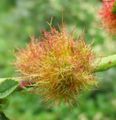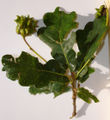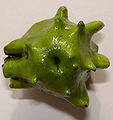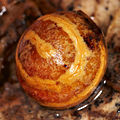- Gall wasp
-
Gall Wasps 
Neuroterus albipes, parthenogenetic generation females, from galls on Quercus robur Scientific classification Kingdom: Animalia Phylum: Arthropoda Class: Insecta Order: Hymenoptera Suborder: Apocrita Superfamily: Cynipoidea Family: Cynipidae Gall wasps (Cynipidae), also called Gallflies, are a family of the order Hymenoptera and are classified with the Apocrita suborder of wasps in the superfamily Cynipoidea. About 1300 species of this generally very small creature (1-8 millimeters) are known worldwide, with about 360 species of 36 different genera in Europe and some 800 species in North America.
Contents
Features
Like all representatives of Apocrita, gall wasps have a distinctive body shape, the so-called wasp waist. The first abdominal tergum (the propodeum) is conjoined with the thorax, while the second abdominal segment forms a sort of shaft, the petiole. The petiole connects with the gaster, which is the functional abdomen in apocritan wasps, starting with the third abdominal segment proper. Together, the petiole and the gaster form the metasoma, while the thorax and the propodeum make up the mesosoma. The antennae are straight and consist of 12 to 16 segments. In many varieties the backside of the mesosoma appears longitudinally banded. The wings are typically simply structured. The female's egg-depositing ovipositor is often seen protruding from the tip of the metasoma.
Reproduction and development
The reproduction of the gall wasp is partly pure two-sex propagation, partly pure parthenogenesis, in which a male is completely unnecessary. With most species, however, there is an alternation of generations with one two-sex generation and one parthenogenic generation annually. This process differentiates the various generations primarily in their appearance and the form of the plant galls they induce.
The larvae of most gall wasps develop in characteristic plant galls they induce themselves, however many species are also inquilines of other gall wasps, such as those of the genus Synergus.
The plant galls mostly develop directly after the female insect lays the eggs. The inducement for the gall formation is largely unknown; discussion speculates as to both chemical, mechanical and viral triggers. The hatching larvae nourish themselves with the nutritive tissue of the galls, in which they are otherwise well-protected from external environmental effects. The host plants and the size and shape of the galls are specific to the majority of gall wasps, whereas about 70% of the known species live in various types of oak tree. One can find galls on nearly all parts of such trees, some on the leaves, the buds, the branches, and the roots. Other species of gall wasp live in eucalyptus trees, rose bushes or maple trees, as well as many herbs. Frequently, the determination of the species is much easier through observation of the galls produced rather than the insect itself.
Parasitism
A gall provides the developing gall wasp with a safe refuge for the most vulnerable stage of its life-cycle, however, many other wasps have found a way to penetrate this defence and parasitise the larva(e) within. Some of these parasitoids use their long, hardened egg laying tube (ovipositor) to bore into the gall and lay an egg on the helpless gall maker. Collect a Bedeguar or robin's pincushions gall before the autumn and keep it somewhere cool. In the spring, you will see at least one species of parasitoid emerge instead of the gall maker. These wasps such as Eurytoma rosae are beautiful, metallic insects with long ovipositors. These parasitoids, may in turn, be preyed upon by other wasps, hyperparasitoids.[1]
Types
Most species of gall wasp live as gall-formers on oaks. One of the most well-known of these oak gall wasps is the common oak gall wasp (Cynips quercusfolii), which induces characteristic two-centimeter in diameter, spherical galls on the underside of oak leaves.
-
Andricus fecundatrix parthenogenetic generation, Oak artichoke gall.
These turn reddish in the fall and are commonly known as oak apples. Light lentiform galls on the underside of the same leaves are induced by Neuroterus quercusbaccarum; darker ones with bulging edges are formed by Neuroterus numismalis. Also striking are the galls of Cynips longiventris, which likewise can be found on the underside of leaves, and are recognizable for their spheroidal shape and irregular red streaks. The oak potato gall wasp (Biorrhiza pallida) has round galls that grow to about four centimeters. These are known colloquially as oak potatoes. The latter type of gall is induced by this type of wasp not on the leaves, but on the roots of the oak. On the buds of young oak twigs, one can often find the hard-shelled galls of Andricus kollari and Andricus quercustozae.
The galls of the rose gall wasp (Diplolepis rosae) are also distinctive and are known as bedeguars or robin's pincushions. These are found on the shoots of dog roses and have a length of up to five centimeters with red long-haired outgrowths. Inside the galls are several chambers, which may be occupied by larvae.
Genera include:
- Andricus
- Biorrhiza
- Cynips
- Diplolepis
- Neuroterus
- Synergus
Additional information
- The galls of several species, especially Mediterranean variants, were once used as tanning agents.
- A rose gallnut with stem makes a long-lasting bouquet adornment.
- Before his work in human sexuality, Dr. Alfred Kinsey was known for his study of gall wasps.[2]
- Galls formed on oak trees are one of the main ingredients in Iron gall ink
See also
- Oak apple
- Oak Marble gall
- Knopper gall
- Rose bedeguar gall
- Common Spangle gall
References
- ^ Piper, Ross (2007), Extraordinary Animals: An Encyclopedia of Curious and Unusual Animals, Greenwood Press.
- ^ Yudell, Michael (July 1), "Kinsey's Other Report", Natural History 108 (6), ISSN 0028-0712, http://findarticles.com/p/articles/mi_m1134/is_6_108/ai_55127889
- This article is based on a translation of the corresponding article from the German Wikipedia.
Further reading
- Gauld, I.D., Bolton, B. (1988): The Hymenoptera, Oxford
- Honomichl, K., Bellmann, H. (1994): Biologie und Ökologie der Insekten (In German)
- Liljeblad, J. (2002): Phylogeny and evolution of gall wasps (Hymenoptera: Cynipidae). Department of Zoology, Stockholm University. 1-176. Doctoral thesis.
External links
 Media related to Cynipidae at Wikimedia Commons
Media related to Cynipidae at Wikimedia Commons- Andricus quercusclavigera and A. quercuscornigera on the UF / IFAS Featured Creatures Web site
Categories:- Cynipoidea
- Galls
Wikimedia Foundation. 2010.








